Fermenting Beer with CellarScience Cali Yeast
Published: August 5, 2025 at 2:20:23 PM UTC
Creating the perfect beer demands a meticulous approach to ingredient selection and brewing methods. The yeast used for fermentation is a critical component. CellarScience Cali Yeast has become a favorite among brewers for its clean and neutral taste. This makes it an excellent choice for a wide range of beer styles. This yeast strain is celebrated for its ability to deliver consistent outcomes. It allows brewers to achieve the precise flavor and aroma they desire in their beers. In this article, we will explore the characteristics, usage, and advantages of employing CellarScience Cali Yeast in beer fermentation.
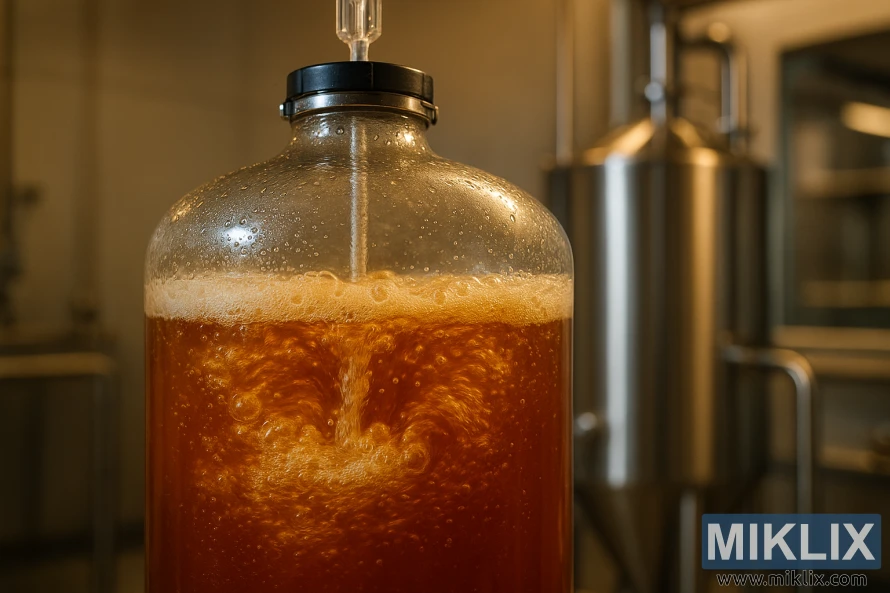
Key Takeaways
- CellarScience Cali Yeast offers a clean and neutral flavor profile.
- It is suitable for various beer styles and produces consistent results.
- The yeast is a popular choice among brewers for its reliability.
- Proper usage and handling are critical for optimal fermentation.
- Using this yeast can enhance the overall quality of the beer.
Understanding CellarScience Cali Yeast
Grasping the characteristics of CellarScience Cali Yeast is key to achieving top-notch brewing results. This dry yeast strain is renowned for its simplicity and consistency. It's a favorite among brewers for these reasons.
Its yeast characteristics are favorable, impacting the quality of brewing ingredients. The yeast's attenuation and flocculation properties are critical. They shape the final product's flavor and clarity.
Knowing the optimal temperature range for CellarScience Cali Yeast is vital. This knowledge ensures the fermentation process goes smoothly. It leads to a high-quality final product.
- Easy to use dry yeast strain
- Consistent results in brewing
- Favorable attenuation and flocculation properties
By utilizing CellarScience Cali Yeast, brewers can craft a variety of beer styles. Each style boasts unique flavors. Its dependability and performance make it perfect for both commercial and homebrewing.
Technical Specifications and Requirements
The success of CellarScience Cali Yeast in brewing hinges on several key technical aspects. Brewers must grasp these to achieve the best outcomes. This yeast boasts medium-high attenuation and medium flocculation properties.
Attenuation is the yeast's skill in fermenting sugars, turning them into alcohol and carbon dioxide. Its medium-high attenuation shows it can ferment a large part of the wort's sugars. This results in a beer that's well-balanced.
The ideal temperature for fermentation with CellarScience Cali Yeast is 59-72°F (15-22°C). Keeping the fermentation temperature within this range is vital. It ensures the desired flavor and proper yeast function.
Flocculation, or the yeast's ability to clump and settle, is also critical. With medium flocculation, CellarScience Cali Yeast forms moderate clumps. This helps in achieving a clean, clear final product.
Optimal Fermentation Conditions
The fermentation process with CellarScience Cali Yeast can be optimized by controlling several key factors. One of the advantages of using this yeast strain is its ability to be pitched directly into the wort without the need for oxygenation. This simplifies the brewing process.
To achieve the best fermentation results, brewers should focus on temperature control and pitching rate. The optimal temperature range for fermenting with CellarScience Cali Yeast should be maintained consistently. This ensures healthy yeast activity and produces the desired flavor compounds.
Here are some brewing tips to optimize fermentation with CellarScience Cali Yeast:
- Monitor and control fermentation temperature.
- Use the recommended pitching rate to ensure adequate yeast cells for fermentation.
- Take advantage of the yeast's ability to ferment without oxygenation, simplifying your brewing process.
By following these guidelines, brewers can achieve a successful fermentation with CellarScience Cali Yeast. This results in high-quality beer with the desired characteristics.
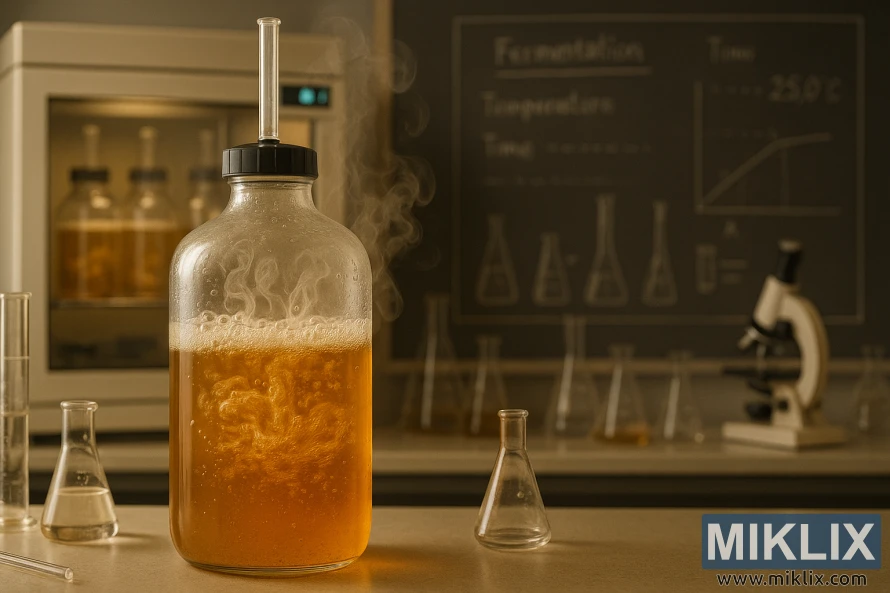
Flavor Profile Analysis
CellarScience Cali Yeast is celebrated for its clean and neutral taste, making it a top pick among brewers. It excels at highlighting malt and hop flavors, perfect for a wide range of beer styles.
The yeast's clean flavor lets the malt and hops take center stage. This is great for brewers aiming to craft beers with unique flavor profiles.
- Crisp, clean taste
- Prominent malt and hop flavors
- Neutral yeast flavor
- Versatility in brewing various beer styles
It's ideal for lagers, ales, and hybrid beers. Its neutral taste is perfect for experimenting with different hops and malts.
Using CellarScience Cali Yeast guarantees consistent fermentation. This, along with its clean flavor, has made it a favorite among both commercial and homebrewers.
Attenuation and Flocculation Properties
CellarScience Cali Yeast stands out for its medium-high attenuation and medium flocculation. This makes it a versatile choice for brewers. The yeast's attenuation level is key in shaping the beer's final gravity and flavor.
Its medium-high attenuation ensures that fermentable sugars are fully consumed. This results in a dry finish and a balanced flavor. The yeast's medium flocculation aids in forming a compact yeast cake. This makes it simpler to separate the yeast from the beer.
These properties make CellarScience Cali Yeast ideal for a broad range of beer styles. Here are some key benefits:
- Efficient fermentation with medium-high attenuation
- Compact yeast cake formation due to medium flocculation
- Versatility in brewing various beer styles
- Balanced flavor profile and dry finish
By understanding and utilizing the attenuation and flocculation of CellarScience Cali Yeast, brewers can enhance their fermentation. This leads to the production of high-quality beers that meet their exact specifications.
Pitch Rate Guidelines
Pitch rate guidelines for CellarScience Cali Yeast are designed to help brewers achieve optimal fermentation results. This yeast can be pitched directly into the wort, eliminating the need for rehydration. This flexibility makes the brewing process easier for brewers.
When deciding between direct pitching and rehydration, brewers should consider the benefits and drawbacks of each method. Direct pitching is convenient and reduces the risk of contamination. On the other hand, rehydration can help ensure a more consistent pitch rate.
The pitch rate for CellarScience Cali Yeast can vary based on several factors. These include the specific gravity of the wort and the desired fermentation temperature. Here are some general guidelines to follow:
- For standard strength beers (1.040-1.060 OG), a pitch rate of 1-2 million cells/mL/°P is recommended.
- For high-gravity beers (1.070-1.090 OG), a pitch rate of 2-3 million cells/mL/°P is suggested.
- Rehydration should be done in water at a temperature between 80°F and 90°F (27°C-32°C).
By following these guidelines, brewers can optimize their fermentation process. This ensures consistent results with CellarScience Cali Yeast.
Comparative Analysis with Similar Yeasts
CellarScience Cali Yeast is a favorite among brewers, but how does it stack up against other yeast strains? A comparison with similar yeasts like WLP001, WY1056, and US-05 reveals interesting insights.
CellarScience Cali Yeast and these popular yeasts share a common trait: clean, crisp flavors. Yet, Cali Yeast has a higher attenuation rate, leading to a drier finish. Its flocculation is similar to WLP001, aiding in achieving a clear beer.
In terms of fermentation, Cali Yeast mirrors US-05's moderate to high rate. Yet, it tolerates a broader temperature range, increasing its versatility in brewing.
CellarScience Cali Yeast brings a unique set of characteristics to the table. While it shares traits with other yeasts, its distinct advantages make it a compelling choice for brewers. It's an excellent option for a wide range of beer styles.
Brewing Performance Metrics
Understanding the brewing performance of CellarScience Cali Yeast is key for optimal fermentation. This yeast strain is renowned for its consistent and reliable brewing performance. It's a favorite among brewers for these reasons.
The brewing performance metrics of CellarScience Cali Yeast include a typical fermentation time of 7-10 days. This timeframe helps brewers plan their production schedules effectively. The yeast's performance is marked by its ability to ferment at a consistent rate. This results in predictable gravity and ABV levels.
The fermentation metrics of CellarScience Cali Yeast are vital for achieving the desired beer quality. Key metrics include:
- Original Gravity: 1.050-1.070
- Final Gravity: 1.010-1.020
- ABV: 6-8%
These metrics show that CellarScience Cali Yeast effectively attenuates fermentable sugars. This results in a well-balanced beer. Brewers can count on this yeast strain to produce consistent results, batch after batch.
To optimize brewing performance, brewers should follow proper pitching rates and fermentation temperature guidelines. By doing so, they can ensure that CellarScience Cali Yeast performs at its best. This produces high-quality beer that meets consumer expectations.
Common Fermentation Issues and Solutions
When brewing with CellarScience Cali Yeast, brewers may encounter several common fermentation problems. Understanding these issues and knowing how to address them is key to achieving the desired beer quality.
One common issue is stuck fermentation, where the fermentation process halts before reaching the desired attenuation. To troubleshoot this, brewers should check the fermentation temperature. It might be too low. They should also ensure the yeast is healthy and properly pitched.
Another issue is over-attenuation, resulting in a drier beer than intended. This can be managed by adjusting the yeast pitch rate. Brewers should also closely monitor the fermentation temperature to prevent it from getting too high.
Under-attenuation, leading to a sweeter beer than desired, is another issue. Ensuring adequate nutrient supply and maintaining optimal fermentation conditions can help mitigate this.
To effectively troubleshoot fermentation issues with CellarScience Cali Yeast, brewers should:
- Monitor fermentation temperature closely.
- Ensure proper yeast pitching rates.
- Verify the health and viability of the yeast before pitching.
- Adjust nutrient supply as necessary.
By following these guidelines, brewers can minimize common fermentation issues. This ensures consistent, high-quality results with CellarScience Cali Yeast.
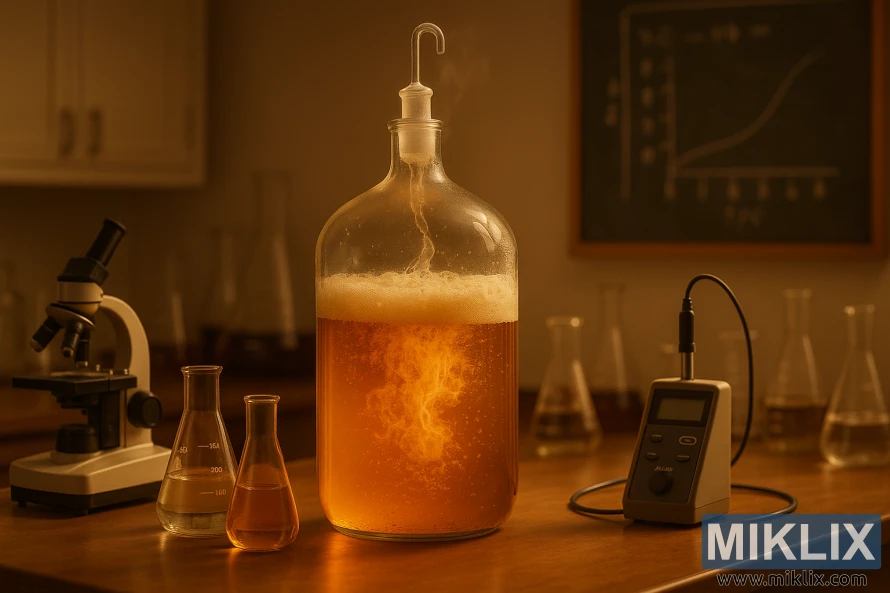
Storage and Viability
Storage conditions are key to keeping CellarScience Cali Yeast effective. Brewers must follow specific guidelines to maintain its quality.
CellarScience Cali Yeast can last up to 2 years if stored correctly. It should be kept in a cool, dry spot, away from sunlight and moisture. The best storage temperature ranges from 4°C to 8°C (39°F to 46°F).
- Store the yeast in its original packaging or a sealed container to prevent contamination.
- Keep the storage area clean and dry to prevent moisture accumulation.
- Avoid exposing the yeast to extreme temperatures or direct sunlight.
By adhering to these practices, brewers can extend the shelf life and viability of CellarScience Cali Yeast. This ensures consistent fermentation results.
Beer Style Compatibility
CellarScience Cali Yeast allows brewers to craft a variety of beers, from ales to stouts and IPAs. This yeast strain is celebrated for its versatility and ability to work well with many beer styles.
CellarScience Cali Yeast is well-suited for brewing:
- Ales: Its neutral flavor profile makes it ideal for ale production.
- Stouts and Porters: It enhances the rich, roasted flavors characteristic of these styles.
- IPAs: The yeast complements the hoppy flavors and aromas of IPAs without overpowering them.
When choosing a beer style to brew with CellarScience Cali Yeast, brewers should consider the yeast's attenuation and flocculation properties. These characteristics influence the final beer's flavor, clarity, and overall quality.
The compatibility of CellarScience Cali Yeast with a wide range of beer styles makes it a valuable asset for brewers. It's perfect for those looking to experiment with different recipes or for those who want to simplify their yeast selection process.
Commercial Brewery Applications
CellarScience Cali Yeast has become a leading choice for commercial breweries. Its standout performance in large-scale brewing is unmatched. It offers consistency and reliability, making it perfect for breweries aiming to increase their output.
Several factors contribute to CellarScience Cali Yeast's suitability for commercial brewing. These include:
- High attenuation rates, resulting in a cleaner fermentation profile
- Excellent flocculation properties, making it easier to manage yeast removal
- A robust fermentation profile that can withstand the stresses of large-scale brewing
Commercial breweries gain from using CellarScience Cali Yeast due to its:
- Consistency in fermentation outcomes, reducing the risk of batch variability
- Reliability in performance, even under varying brewing conditions
- Ability to produce high-quality beers that meet consumer expectations
By choosing CellarScience Cali Yeast, commercial breweries can improve their brewing operations. This yeast's performance characteristics are invaluable for breweries looking to optimize their fermentation processes.
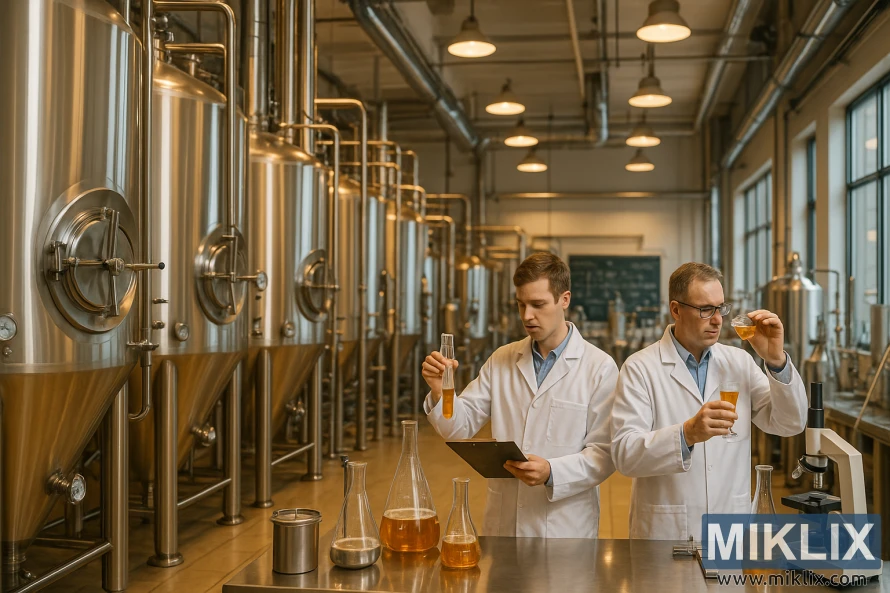
Homebrewing Success Tips
To brew exceptional beer with CellarScience Cali Yeast, homebrewers should focus on optimizing their fermentation conditions. This involves maintaining a consistent temperature within the recommended range for the yeast strain.
CellarScience Cali Yeast is known for its ease of use and consistent fermentation performance. It's an ideal choice for homebrewers of all experience levels. By understanding the characteristics of this yeast and following best practices, homebrewers can achieve high-quality results.
Here are some key considerations for homebrewers using CellarScience Cali Yeast:
- Pitching rate: Ensure that you are using the correct amount of yeast for your batch size to avoid under or over-pitching.
- Fermentation temperature: Maintain a consistent temperature within the recommended range to promote healthy fermentation.
- Monitoring fermentation: Regularly check on the fermentation progress to identify any common issues early.
By following these guidelines and being mindful of the specific needs of CellarScience Cali Yeast, homebrewers can troubleshoot common issues. This leads to consistent, high-quality results.
Quality Control Measures
CellarScience Cali Yeast is crafted with meticulous attention to quality, adhering to stringent control measures. Ensuring the highest quality yeast is essential for consistent brewing results.
The production process of CellarScience Cali Yeast involves thorough quality control checks. These checks guarantee its purity and consistency. It includes rigorous testing for contaminants and verification of its fermentation performance.
The quality control measures for CellarScience Cali Yeast have significant implications for brewers. By using a yeast product with verified quality, brewers can minimize the risk of fermentation issues. This ensures consistent beer quality.
- Rigorous testing for contaminants and spoilage organisms
- Verification of fermentation performance under various conditions
- Consistency in yeast quality to ensure reliable brewing outcomes
For brewers, using CellarScience Cali Yeast means benefiting from a product made under strict quality control guidelines. This enhances the quality of the final beer product. It also contributes to a more efficient and reliable brewing process.
By choosing CellarScience Cali Yeast, brewers can trust they are using a high-quality yeast product. This meets the demands of both commercial and homebrewing applications.
Environmental Impact and Sustainability
CellarScience Cali Yeast is revolutionizing the brewing industry with a focus on environmental sustainability. The company is dedicated to reducing its ecological footprint through its production and packaging methods. This commitment showcases its role in setting new standards for the industry.
CellarScience Cali Yeast has introduced several eco-friendly practices to minimize its environmental impact. These include:
- Eco-friendly packaging materials that are biodegradable and recyclable.
- Sustainable sourcing of raw materials to minimize carbon footprint.
- Energy-efficient manufacturing processes that reduce energy consumption.
- Waste reduction programs aimed at minimizing waste during production.
These sustainable practices not only benefit the environment but also enhance the quality of CellarScience Cali Yeast. By using eco-friendly packaging, the company reduces its reliance on non-renewable resources and minimizes waste.
The implications of these practices for the brewing industry are profound. As brewers increasingly prioritize sustainability, the demand for eco-friendly yeast products like CellarScience Cali Yeast is expected to rise. This shift towards sustainability could lead to a more environmentally conscious brewing industry overall.
Breweries can further enhance their sustainability by adopting additional practices such as:
- Using locally sourced ingredients to reduce transportation emissions.
- Implementing water conservation measures to minimize water usage.
- Investing in renewable energy sources to power their operations.
By combining CellarScience Cali Yeast with these sustainable brewing practices, breweries can significantly reduce their environmental impact. This allows them to produce high-quality beers while being more environmentally conscious.
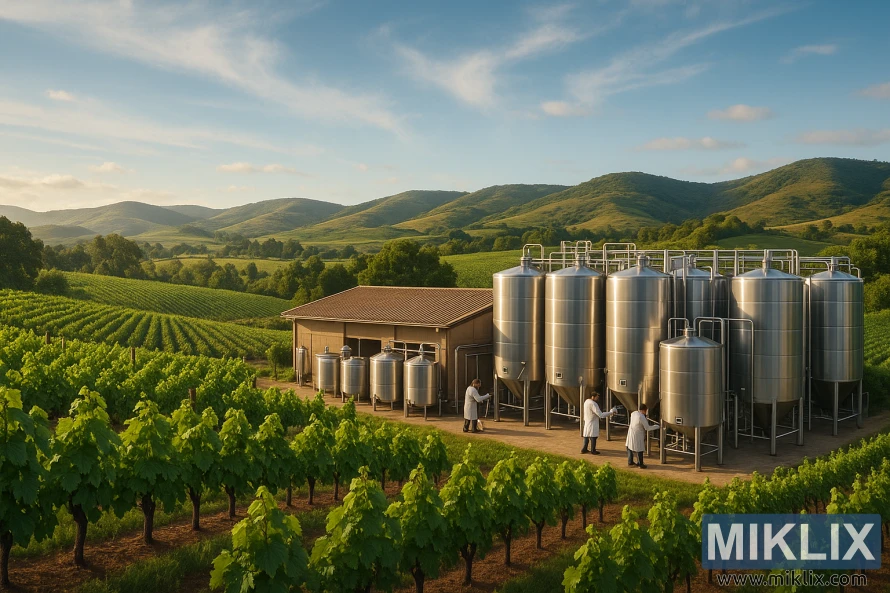
Conclusion
CellarScience Cali Yeast has proven itself as a top-notch yeast strain for brewers. It delivers consistent results across different beer styles. Its technical specs and ideal fermentation conditions make it perfect for both commercial breweries and homebrewers.
The yeast's flavor profile and attenuation properties add to its versatility. This allows brewers to create a wide variety of beers with unique characteristics. As the brewing industry grows, CellarScience Cali Yeast will likely play a key role in shaping future beer flavors.
In conclusion, CellarScience Cali Yeast is a valuable asset for brewers aiming to produce high-quality beers. Its ability to work well with various beer styles and its strong fermentation performance make it a great choice. It's ideal for those looking to innovate and improve their brewing techniques.
Further Reading
If you enjoyed this post, you may also like these suggestions:
- Fermenting Beer with Bulldog B38 Amber Lager Yeast
- Fermenting Beer with Wyeast 3068 Weihenstephan Weizen Yeast
- Fermenting Beer with Lallemand Sourvisiae Yeast
